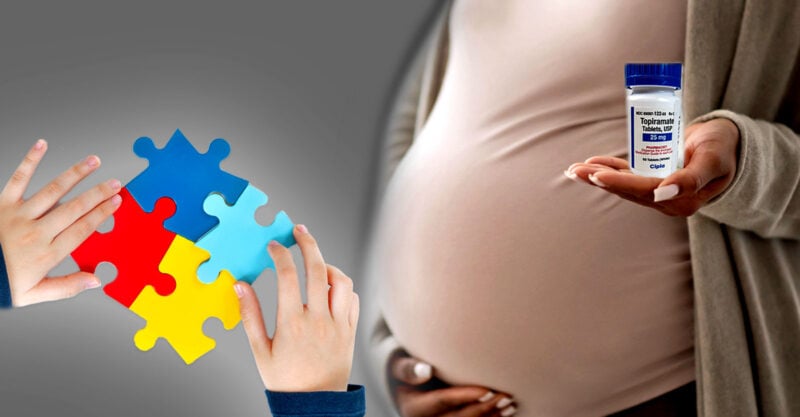Miss a day, miss a lot. Subscribe to The Defender's Top News of the Day. It's free.
Topiramate, an antiseizure medication, when taken by pregnant women did not appear to increase the risk of their children developing autism spectrum disorder (ASD), according to the authors of a new study.
However, Brian Hooker, Ph.D., chief scientific officer at Children’s Health Defense (CHD), questioned the study’s findings, and whether the researchers manipulated the data in a way to obfuscate a possible connection.
“This study is fundamentally flawed,” Hooker — who has a child with autism — told The Defender. “It just seems like they designed a study to not find things.”
Researchers at the Harvard T.H. Chan School of Public Health analyzed the health records of mothers with epilepsy who took topiramate, seeking to determine if the drug increased their children’s risk of autism.
Topiramate — sold by Johnson & Johnson’s subsidiary Janssen Pharmaceuticals under the brand name “Topamax” — is also prescribed to treat migraines, bipolar disorder and weight management.
The researchers compared the mothers’ records with records from mothers with epilepsy who took two other antiseizure medications — lamotrigine and valproate sodium — and with records from mothers with epilepsy who did not take any antiseizure medication.
The researchers’ data, published March 21 in The New England Journal of Medicine, initially showed that kids who were exposed in utero to topiramate had an autism incidence rate of 6.2% at age 8 — 2% higher than that of children born to epileptic mothers who had not taken an antiseizure medication during pregnancy.
However, after adjusting their statistical model to account for other possible risk factors — called “confounding variables” — that the researchers thought might be associated with both the use of anti-seizure medications and with ASD diagnosis in the baby, the data no longer showed that topiramate appeared to increase kids’ risk of ASD when exposed prenatally.
Hooker criticized the methodology. He said researchers could have done what’s called a case-control study to help them clearly assess if there was a relationship between topiramate and ASD, but they didn’t do that.
Instead, the Harvard researchers did what’s called a cohort study by looking at data records of nearly 4.3 million pregnant women and their children from 2000 to 2020.
They compared the autism rates between groups, or “cohorts,” such as the group of kids whose mothers had epilepsy and took topiramate during pregnancy, the group of kids whose mothers had epilepsy but did not take an antiseizure medication and the group of kids whose mothers didn’t have epilepsy or take an antiseizure medication.
For this type of study design to produce meaningful results, it’s important that the cohorts are “basically similar,” Hooker said.
But Hooker said the cohorts were “so poorly matched” that it was “impossible” to draw a conclusion about topiramate and the prevalence of autism. “This gave the authors an ‘out’ as far as dismissing any relationship found between topiramate in pregnancy and ASD,” he said.
For instance, the moms with epilepsy in the topiramate group exhibited higher rates of smoking, illicit drug use and the use of other prescriptions compared to the moms in the group who had epilepsy but had not taken antiseizure medications.
The researchers could have controlled for these differences by dropping women who smoked or used illicit drugs from their dataset — and they still would have had a large enough sample size to get meaningful statistical results.
But they didn’t do that, Hooker said. “Instead, they chose to ‘model their way’ out of a relationship using many covariates that were not controlled for.”
In other words, the researchers “muddied the waters” by adding extra variables that they could blame for causing the increased risk of autism, he said, leaving topiramate off the hook.
“It is really too bad,” Hooker said, because clear information about topiramate’s relationship to ASD is “so vital to have.”
The study’s lead author, Dr. Sonia Hernández-Díaz, disagreed with Hooker.
Hernández-Díaz — who until 2023 was a methods consultant to Johnson & Johnson for pregnancy studies — told The Defender in an email that she and her team designed their study “to assess whether the anti-seizure medication had an effect on the risk of ASD.”
According to Hernández-Díaz, the researchers did a cohort study rather than a case-control study because they “had the opportunity to analyze the data as a cohort (i.e. use the full information) and because an ad hoc case-control study would be prone more to biases (e.g. selection of controls and recall bias of prenatal exposure).”
Hooker said he didn’t agree with Hernández-Díaz’s assessment of case-control studies. “I think she’s introduced biases in doing the cohort study instead.”
Hernández-Díaz also said she and her team “did try to create more homogeneity between treatment groups by adjusting for many factors.”
When asked why they did not eliminate women who smoked or used illicit drugs from their dataset so they could make cleaner comparisons, Hernández-Díaz said that a randomized clinical trial on antiseizure medications would not be restricted to non-smokers.
More than 100 families sue over congenital malformations
Topiramate has been the center of controversy for more than a decade.
Research shows that prenatal topiramate exposure can cause babies to be born smaller than expected for their gestational age and may also cause congenital malformations, particularly oral clefts.
As of 2013, more than 130 families filed lawsuits against Janssen, alleging the company failed to warn women and their doctors about the drug’s risks when used during pregnancy.
Additionally, two other Johnson & Johnson subsidiaries in 2010 were forced to pay more than $81 million for illegally promoting Topamax off-label.
UK launches safety review of topiramate
The U.K. government in July 2022 launched a new safety review of topiramate after Nordic researchers earlier that year linked prenatal exposure to topiramate to an increased risk of ASD, intellectual disability and neurodevelopmental disorders.
The Nordic researchers, who published their findings in JAMA Neurology, analyzed health data from 4.5 million mother-child pairs.
They found a “clear risk of adverse neurodevelopment” in children exposed prenatally to topiramate — especially when the mom was taking doses of 100 milligrams or more a day, they said.
The recent Harvard study appears to be a response to the Nordic study, Hooker said. “It’s an echo.”
For example, the headline of the Harvard study’s press release downplayed a possible connection by saying topiramate “may not” increase children’s risk of ASD.
“It’s almost like they’re using ‘weasel words,’” Hooker said, “to cover their own behinds with this very flawed study.”
The study appears to send the message, “Nothing to see here in the U.S. — so don’t stop taking your meds,” he added.
Study co-author Kathryn Gray, M.D., Ph.D., serves as a consultant to Janssen Global Services.
Apart from her and Hernández-Díaz, the study’s authors disclosed no ties to Johnson & Johnson or its subsidiaries.
Hernández-Díaz said her consultancy for Johnson & Johnson involved only a few hours and little money, and did not affect the design, analysis or interpretation of the study’s results. “Even if I had been unconsciously biased, my co-authors would not have allowed me to misinterpret the results,” she said.
She said it’s possible the results of the NEJM study are not correct, but if so, she did not think it was because of a faulty study design. She said she is the one who hypothesized that topiramate would increase the risk for ASD. “I might be wrong, and I might make mistakes, but I try to find the truth.”
Hernández-Díaz also said it was her research that produced the scientific evidence on the impact of topiramate on oral clefts.
The study was supported by a grant from the National Institute of Mental Health.
This article was updated to clarify that Hernández-Díaz’s Johnson & Johnson consultancy was for minimal time and compensation and that she was a key researcher in uncovering the link between topiramate and oral clefts.









